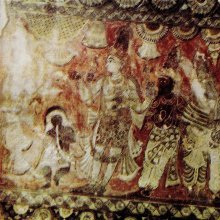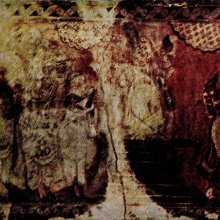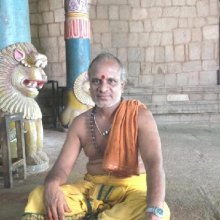Anugrahamurti, Anugrahamūrti, Anugraha-murti: 2 definitions
Introduction:
Anugrahamurti means something in Hinduism, Sanskrit. If you want to know the exact meaning, history, etymology or English translation of this term then check out the descriptions on this page. Add your comment or reference to a book if you want to contribute to this summary article.
Images (photo gallery)
In Hinduism
Shilpashastra (iconography)
Source: Wisdom Library: Śilpa-śāstraAnugrahamūrti (अनुग्रहमूर्ति) refers to “boon-conferring aspects”. It is one of the five classes of śivamūrti (‘image of Śiva’).The term is used throughout Śilpaśāstra literature.
Source: Archaeological Survey of India: Śaiva monuments at Paṭṭadakal (śilpa)Anugrahamūrti (अनुग्रहमूर्ति) is a sculpture found at the temple of Vijayeśvara, at the western side, northern karṇakūṭa .—This is one of the most beautiful and rare images of Śiva blessing one of his devotees. Śiva is standing and an emaciate dwarf personage holds firmly the right leg of the god reminding us the story of Mārkaṇḍeya or Śveta. But in the case of these two devotees they are shown embracing the Liṅga and not God Śiva. Śiva’s right hand is on the head of the devotee. The ribs of the dwarf are seen like in the figure of Karaikālammeyār, great devotee of Śiva. One can count his ribs. The dwarf is a male. Śiva’s hand on the head makes us to think of the story of Caṃḍikeśvara. But the hand does not show the gesture of benediction.
Śiva looks so peaceful as if satisfied with the devotion of his devotee and blesses him. Śiva is standing in tribhaṅga, “three bends” with his head tilted to the left, hips also to the left and in cross feet like the pose of Kṛṣṇa. Śiva is holding a snake in the upper right hand, flag staff in the upper left. The lower left is raised and the palm is in the gesture of sarpaśīrṣa, snake-hood, the lower right on the head of the devotee.

Shilpashastra (शिल्पशास्त्र, śilpaśāstra) represents the ancient Indian science (shastra) of creative arts (shilpa) such as sculpture, iconography and painting. Closely related to Vastushastra (architecture), they often share the same literature.
See also (Relevant definitions)
Partial matches: Anugraha, Murti.
Ends with: Candeshanugrahamurti, Chandeshanugrahamurti, Vishnvanugrahamurti.
Full-text: Shivamurti, Candeshanugrahamurti, Vishnvanugrahamurti.
Relevant text
Search found 3 books and stories containing Anugrahamurti, Anugrahamūrti, Anugraha-murti, Anugraha-mūrti; (plurals include: Anugrahamurtis, Anugrahamūrtis, murtis, mūrtis). You can also click to the full overview containing English textual excerpts. Below are direct links for the most relevant articles:
The Religion and Philosophy of Tevaram (Thevaram) (by M. A. Dorai Rangaswamy)
Introduction to second volume < [Volume 2 - Nampi Arurar and Mythology]
Chapter 2.1 - Vishapaharana-murti (depiction of swallowing the poison) < [Volume 2 - Nampi Arurar and Mythology]
Chapter 2.5 - Ravana-anugraha-murti (depiction of the Ravana) < [Volume 2 - Nampi Arurar and Mythology]
Early Chola Temples (by S. R. Balasubrahmanyam)
Muktesvaram < [Chapter XIV - Conclusion]
Middle Chola Temples (by S. R. Balasubrahmanyam)
Temples in Tiruvalisvaram < [Chapter II - Temples of Rajaraja I’s Time]
Temples in Gangaikondasolapuram (Gangaikondacholapuram) < [Chapter IV - Temples of Rajendra I’s Time]
Related products



